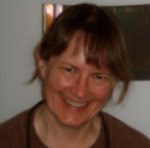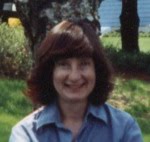The iPad version of BlockFab (BlockFab-HD), includes some patches and blocks with curves. The two basic curved patches included are the pie and the crust, names often associated with the two pieces used in the Drunkard's Path block and its variants. For those of you who haven't dealt with curves before, we'll spend some time helping you to master this technique.

When placed next to each other, the two pieces of the Drunkard's Path block don't look like they'll fit together. Never fear: that's the nature of arcs and curves, and once they are sewn together, they will fit perfectly!
After cutting out the shapes, fold the pieces in half along the curved edges and mark the midpoint of each curve. You can use a pin, a marking pencil, or a tiny notch. These marks will be used to match up the center points of the curves.

The key to success is pinning the pieces properly. The straight edges at the ends of the curves of the two pieces should align exactly. So first lay the crust piece on the pie piece, right sides together, with the straight edges aligned as shown. Pin the pieces, with the pin parallel to the straight edges. This will keep them properly aligned while sewing.
Next, swing the curve on the top piece (the crust) around and align the straight edges at the other end of the curves and pin as on the first side. You should now be able to match up the midpoints that you previously marked, aligning the edges and inserting the pin perpendicular to the edge, as shown below.
Depending on the size of your pieces, you may want to insert 2 or 4 more pins. Be sure the curved edges of the fabric are lined up where you pin. The fabric between the pins will be eased in as you sew. Now sew your 1/4" seam allowance. Go slowly, and remove the pins as you approach them and ease in the fabric as needed. (The line where you sew will match up exactly with the bottom piece, but the top seam allowance will fan out just a bit.)

When finished, the seam can be pressed to either side, depending on which fabric is darker, or which way the seams on adjacent blocks lie.
With practice, you may want to try it without pins! Check out this YouTube video to see a video of how one quilter accomplishes this. Myself, I'll stick with my pins!











































